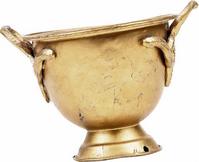
Pewter takes many forms so you will even see a bowl like this. For many persons, the sight of the pewter is a novelty because we are more accustomed to seeing, and in fact using, other types of metals for utensils.
Physically, pewter is a bright, shiny metal that is very similar in appearance to silver. Pewter was common from the Middle Ages and was the chief tableware until the making of China ware.
Pewter care
Today, popular pewter artefacts include unlidded mugs and lidded tankards, porringers, plates, dishes, basins, spoons, measures, flagons, communion cups, teapots, sugar bowls, and cream jugs.
They hardly leaver anything out.
Pewter dates back to the Roman days and was something only the wealthy could afford. Today's pewter is cheaper and safe for eating and drinking.
Older pieces, that may contain lead, oxidise, creating a soft patina and antique look that manufacturers try to simulate today.
Pewter can be pitted or stained from certain foods, such as citrus juice and types of salad dressings, so wash immediately after use.
Do not place in the oven, on a hotplate or near hot flames because pewter melts easier than other types of metals. Pewter melts at only 450 degrees.

Sterling silver from the antique fair at Campion College on November 11 last year. - Avia Ustanny
Always hand-wash rather than placing in a dishwasher.
Unlike silver, pewter doesn't tarnish, so you will not need to clean it all that often.
Antique silver
If silver is your preferred plate, not to worry. We're sure that we have over time given some advice on the cleaning of silver but it's worth repeating. After all, you will want to take good care of those pieces you have spent so much money on. Remember, it's an investment. So, to care for antique silver, there are a number of safe silver polishes available.
Use with a soft cloth and make sure to remove all traces of polish. Try using ear swabs for difficult areas. Avoid using toothbrushes when cleaning as they could scratch the surface. Don't over-polish silver as you can erase decorations and eventually wear the metal thin.
Wash antique silver quickly in lukewarm soapy water. Rinse and dry very thoroughly.
Wrapping in an anti-tarnish cloth will help protect the sheen when not in use.
- Outlook team

